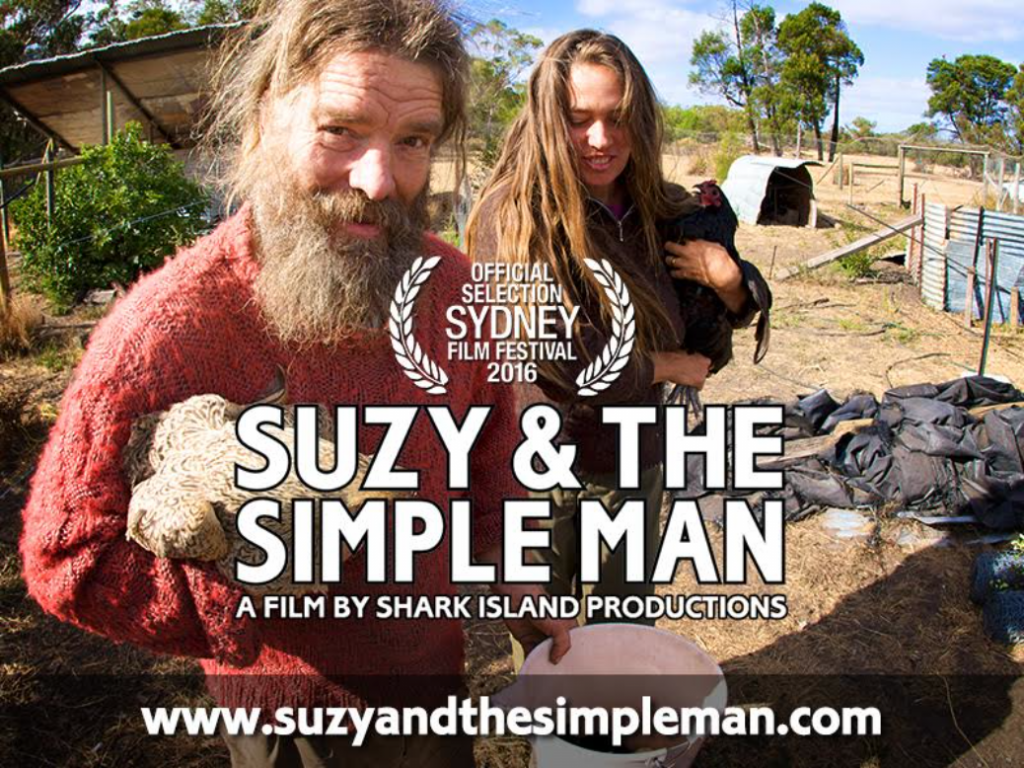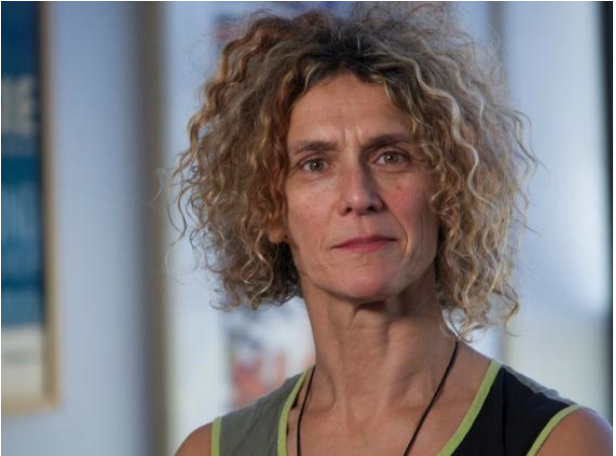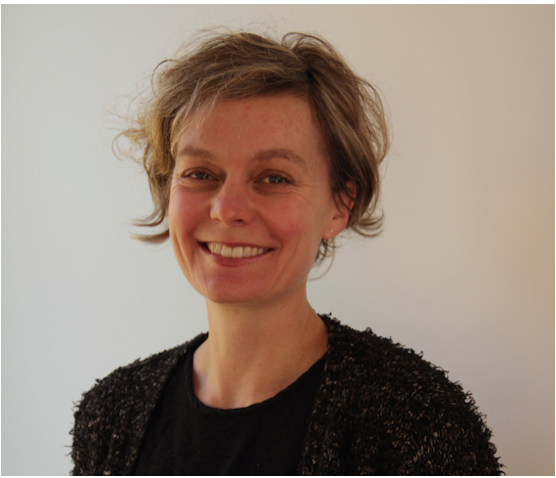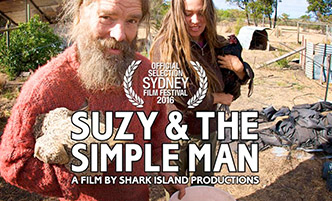Suzy and the Simple Man – Co-edited by Sally Fryer ASE and Hilary Balmond.

Tell me a little bit about yourselves and your career as editors.
 Sally Fryer: I began editing in about 1986 in London. The first job I ever got was, I reckon, the last ever formal 'trainee assistant editor’s’ job to appear on the union job list in London. Those were the days when you had to be a member of the union to get a job and had to have a job to be a member of the union. I was willing to take any job in TV and that was the first job that came up. I was lucky enough to be employed by a gorgeous editor and man called Dan De Waal who retired only last year and who spent the last 8 to 10 years of his career in Bristol working for Testimony Films with the amazing Steve Humphries. I started work on Channel 4’s weekly news show called ‘A Week in Politics’ so was lucky enough to work from the start with great and experienced journalists and storytellers. Turning around a weekly show was also a great learning curve. I came to Sydney in 1998 and got my first job with the ABC Natural History unit down in Melbourne and my second job in Bondi with Hilton Cordell. After 19 years of busy freelance work I was lucky enough to be given a full time position with Ian Darling at Shark Island Productions in 2005.
Sally Fryer: I began editing in about 1986 in London. The first job I ever got was, I reckon, the last ever formal 'trainee assistant editor’s’ job to appear on the union job list in London. Those were the days when you had to be a member of the union to get a job and had to have a job to be a member of the union. I was willing to take any job in TV and that was the first job that came up. I was lucky enough to be employed by a gorgeous editor and man called Dan De Waal who retired only last year and who spent the last 8 to 10 years of his career in Bristol working for Testimony Films with the amazing Steve Humphries. I started work on Channel 4’s weekly news show called ‘A Week in Politics’ so was lucky enough to work from the start with great and experienced journalists and storytellers. Turning around a weekly show was also a great learning curve. I came to Sydney in 1998 and got my first job with the ABC Natural History unit down in Melbourne and my second job in Bondi with Hilton Cordell. After 19 years of busy freelance work I was lucky enough to be given a full time position with Ian Darling at Shark Island Productions in 2005.
 Hilary Balmond: I began editing in high school. In 1988, our bicentennial year, I was attending one of the 25 ordinary NSW public high schools that became ‘Technology High Schools’. This meant computer labs more computer labs, one Canon ‘ion’ camera, a very big video camera and one glorious VHS editing machine. It was awesome. I’d never seen anything like it and no one had a clue how to use it. It consumed many of my lunchtimes and established my love of editing and documentary filmmaking. After studying Theatre and Media Production at Charles Sturt University in Bathurst I spent a few years working in Theatre and post production in Edinburgh and Bristol and making travel films to pay for a few extra trips on the side. Upon my return home, David Goldie and Sohail Dahdal took me on as Associate Producer for their newly formed company and in this role I also cut my first shows for TV. Then after the birth of my first daughter, fate led me on a path toward Sally and Shark Island films – via Bondi Rescue. I assisted Sally on two films, babe literally in arms, ‘In the Company of Actors’ and ‘The Oasis’ and in this environment with Sally and Ian I gained the skills and confidence to cut my first feature doc, ‘A Common Purpose’, with Mitzi Goldman as Director. After a stint cutting reality TV in the UK, I returned again to begin my beautiful journey with Suzy and the Simple Man. That was five years ago now and a few TV docs later, I’m pleased as punch to have cut two feature docs that are screening at the Sydney Film Festival this year. These are of course ‘Suzy and the Simple Man’ and ‘Night Parrot Stories’ by Rob Nugent. I’m feeling like this is a bit of a high point in my still very junior editing career.
Hilary Balmond: I began editing in high school. In 1988, our bicentennial year, I was attending one of the 25 ordinary NSW public high schools that became ‘Technology High Schools’. This meant computer labs more computer labs, one Canon ‘ion’ camera, a very big video camera and one glorious VHS editing machine. It was awesome. I’d never seen anything like it and no one had a clue how to use it. It consumed many of my lunchtimes and established my love of editing and documentary filmmaking. After studying Theatre and Media Production at Charles Sturt University in Bathurst I spent a few years working in Theatre and post production in Edinburgh and Bristol and making travel films to pay for a few extra trips on the side. Upon my return home, David Goldie and Sohail Dahdal took me on as Associate Producer for their newly formed company and in this role I also cut my first shows for TV. Then after the birth of my first daughter, fate led me on a path toward Sally and Shark Island films – via Bondi Rescue. I assisted Sally on two films, babe literally in arms, ‘In the Company of Actors’ and ‘The Oasis’ and in this environment with Sally and Ian I gained the skills and confidence to cut my first feature doc, ‘A Common Purpose’, with Mitzi Goldman as Director. After a stint cutting reality TV in the UK, I returned again to begin my beautiful journey with Suzy and the Simple Man. That was five years ago now and a few TV docs later, I’m pleased as punch to have cut two feature docs that are screening at the Sydney Film Festival this year. These are of course ‘Suzy and the Simple Man’ and ‘Night Parrot Stories’ by Rob Nugent. I’m feeling like this is a bit of a high point in my still very junior editing career.
Suzy and the Simple Man is a documentary 8 years in the making. Did the producers know it would take 8 years, and what is the starting point in planning post-production for such an ambitious project?
SF: I think that at the very beginning of the project Ian Darling - the Director and I had just envisaged a year of filming. We had worked together on a film about Jon Muir called Alone Across Australia which we finished in about 2003.
That was a story about the adventurer Jon Muir who took his dog for a walk - a very long walk - from the South Coast of Australia near Adelaide straight across the content to the north coast. I had met Jon through making that film and loved him and admired him as a person. I loved his adventuring life, his whole attitude to life and the fact that he lived sustainably in the footholds of the Grampians. I always wanted to know more about him because he is a truly special individual. When he and Suzy settled together on their property, Ian and I both thought there might be a film in watching such a remarkable couple live through the four seasons at their home ‘Inanna’. Jon had filmed himself whilst walking across Australia and the footage was intimate and fantastic. We believed that he and Suzy could do a similar job recoding the rhythm of their own life - so Ian talked to them, we sent down a camera and piles of tapes, and the adventure began. I think we also always felt it was a film that we might be able to fit around other projects that came up. It hadn’t been commissioned and therefore we could take our time making it.
HB: I came on board after Jon and Suzy had been filming their lives for quite some time – I couple of years I think. Sally and her assistant at the time, Ania Freer, had been meticulously logging this footage as it trickled in during other projects and they had begun to cut some scenes. I don’t think anyone really ever knew for sure how long the process of making this film would take. If you prepare well, then the transition to post production is pretty painless really – even when the project needs to be handed over to someone else.
I’m guessing a traditional feature doc usually takes between 12 – 18 weeks to edit (longer if the budget allows). How many weeks/months did this film eventually take to edit?
SF: The beauty of this film was that we wanted to make the film without involving a broadcaster so there were therefore no tight deadlines. The budget for filming was very reasonable as Jon and Suzy were happy to do the vast majority of the filming themselves - building it into the rhythm of their life and learning lots along the way - especially Suzy. So, filming and compiling began in September 2008 and we premiered at the Sydney Film Festival this June. But, we were by no means sitting in the edit suite for 8 years.
HB: That’s really hard to work out. We were being led by Jon and Suzy and were lucky not to have any real time constraints from funding bodies or broadcasters. I initially worked a solid four months which included period of working part time as I had a young family to look after and it was wonderful that Ian understood this and was willing to work this way. Then there were several other sporadic weeks of collaboration and cutting between Sydney and the Southern Highlands over the next few years.
How, logistically, did co-editing work?
SF: I began quietly digitising and editing SUZY & THE SIMPLE MAN - which was initially called ‘Our Little Garden’ - in 2008, as soon as filming started and was doing so - digitising rushes and compiling scenes - until Ian Darling and David Leser managed to persuade Paul Kelly, the singer songwriter, to commit to making a doco about himself and his music. This began filming and simultaneously editing in mid 2010 and eventually premiered at Sydney Film Festival and MIFF in 2013. The plan was to pick up with 'Our Little Garden’ once Paul Kelly was finished and Ania Freer came on board as edit assistant to continue digitising and logging the Jon and Suzy footage and also to help with Paul Kelly stuff. Hilary was off editing ‘A Common Purpose’ - and other films during that time. Paul Kelly - Stories of Me was a fantastic doco to work on and I’m very proud of it. But, as can happen, I ‘lost my marbles’ for a while at the end of that edit and spent some gentle time dealing with clinical depression. Ho hum. I’m sure I’m not the only editor to have done that. Hilary was suggested to us by Ania as an editor who would just love to work on a project like Our Little Garden and so Ian brought her on board to take over the project as I didn’t feel like rushing back into an edit suite for a while.
HB: I began editing in earnest in early 2012. Sally wasn’t well at that time and I was really honoured when Ian asked me if I’d like to step in and take on the editing of this film. Although I’d heard a lot about this wonderful project and these remarkable people I was still unfamiliar with the footage and there were still more tapes coming in. However, because the project had been so well organized from the start and because some scenes had already been cut I had a good idea of the essence of what Sally was going for at the time. Ian gave me time and space to really get to know what had been shot and compiled so far and within a few weeks I had the first - 6 hour – cut. I was also cutting remotely, having moved out of Sydney to the country myself so I was very, very alone with the footage for quite some time. Ian would come down occasionally and Vimeo was also a useful tool to share cuts and ideas. I think my remoteness intensified my connection with the footage and with Jon and Suzy’s life. Then Ian and I would work for two or three weeks in the suite in Sydney and show rough cuts during this time and gradually the film began to take shape. From memory, we were working towards festival entry deadlines but then, Suzy needed to concentrate on getting better so we all took a break. I think everybody’s lives then filled up with other things – projects, journeys, family, Good Pitch, healing. So, it was quite incredible to receive a phone call from Sally in May this year to say that the film had been accepted into the Sydney Film Festival at, lets say, fine rough cut. And it just seemed perfect that she should be the one to take the film, with Ian, right to the end – to finish the journey they had started and loved many years before.
Editing is a very personal thing, with each editor having a unique rhythm and style that defines them. How did you develop a common ‘editing language’ for the edit?
SF: When Hilary took over the project there were some sequences that had been cut - in long form - and she was able to look at these to get a sense of the type of footage that was being sent in, but Ian and I also felt that it was absolutely crucial for Hilary to have the time to watch all of the rushes herself. So from the start of 2013 the edit was in fact Hilary’s edit. She did a lot of work at home and then Ian and she spent a chunk of time at Shark Island nutting out the story. What was amazing about the footage for this film and the lifestyle that we were trying to portray is that the rhythm of the film was in effect dictated by the gentle pace at which Jon and Suzy both lived their life. Because much of the filming was done on locked off cameras I’m sure that Hilary and I both felt the same about the rhythm at which the film needed to be cut. During the course of filming over such a long period of time both Hilary and I had got to know Jon and Suzy and I think the cutting of the film really does reflect their gentle/so not urban lifestyle.
HB: We worked on this film together in something like a story structure – Sally took the beginning and the end and I took the middle. Of course that wasn’t planned but that’s how it turned out. So our rhythms never really interrupted each other. Having said that, we are always going to do some things differently and it great when we can share each other’s clever tricks and ideas and we get really excited by that – it only enhances the work of both of us. Regardless, we couldn’t have helped falling into similar rhythms anyway. There was a great sense of peace that came from a lot of the footage and Jon and Suzy’s lives that we all felt. They certainly had their frustrations though and these were felt all the more keenly against that background of calm. I think Sally and I just trust each other and have a similar view of the world.
How did you manage to maintain momentum and a ‘big picture’ vision for the film over such a long period of time?
SF: I guess the big picture vision of the film came from Ian Darling, the Director and from Jon and Suzy as co-directors and cinematographers. But all 5 of us shared that vision. There were also moments in the film when the amount of filming done by Jon and Suzy slowed down and, at one point, came to a halt. Suzy and Jon decided to stop filming altogether when Suzy had her mastectomy and once they came back from their boat trip. Suzan and Jon wished to concentrate on getting better and we totally respected that. Suzy’s health was way more important then finishing the film at that stage and the emergence of such a major challenge to her health as cancer also meant that we did not know ultimately what story path the film would take. There was a time when we though that the cancer story might not make it into the film and that the film would become a much gentler film about growing an organic garden.
HB: There were several breaks where we all got involved in other films and projects but it was always exciting waiting to see what the next installment of Jon and Suzy’s story would be when we knew a new tape would be arriving soon. It’s always good to have an opportunity to take some distance too and when we were working we were working really hard. The breaks were also a good time to get some feedback on the current evolution of the film. The big picture itself had maybe three or four different versions - and Ian and Sally and Mary Macrae (the film’s producer) and I would have great discussions about what sort of film we were making now. Ian communicated with Jon and Suzy a lot so their voice was always present in the cutting room too even though they were far away.
Did you mostly agree on a storytelling strategy for the film, or was there a lot of disagreement? How did the collaboration work in this respect?
SF: If there were moments where our views differed then all 3 of us would think about the film together. I think that as experienced editors we are also able to be very pragmatic about solving storytelling issues.
The collaboration worked so well because whilst Hilary was doing the major part of the storytelling workout with Ian in blocks in cutting room, I was able to come in from time to time with a set of new - but very well informed eyes.
I think the biggest ‘gift’ for me and possibly the most frustrating aspect for Hilary was that when we entered the Fine Cut for the Sydney Film Festival we weren’t necessarily expecting the film to get in. When it was accepted we had just 2 weeks of fine cutting and then a very squished sound post and music composition period of time. Being offered the opportunity to fine cut a film where another editor that you respect highly has done all of the hard work is just a dream….a gift. Hilary was editing another job and as the film was at that time sitting in the Shark cutting room it fell back into my lap. That process however was still very collaborative and Hilary came up to watch my fine cut of her fine cut and she gave her feedback.
HB: I think there were moments of disagreement but everyone had the opportunity to say their piece and try things their way. I would worry if there wasn’t any disagreement - I think we all know it’s a healthy thing to have in a process. Sometimes it’s good to discover you were right and sometimes its great to discover that you were wrong and end up in a much better place. The story telling strategy changed from time to time as new things came to light in Jon and Suzy’s lives so there was always something to nut out – particularly in terms of structure as the film covered so many years. I was lucky to have time and space to really work things through on my own before bringing them to Sydney to present to the rest of the team.
What, if any, are the most frustrating aspects of co-editing? And what are the most rewarding?
SF: The most rewarding aspect for me of working with Hilary was being able to rip off her completely brilliant ‘photo/notebooks’ idea for all future cutting. Hilary prepped these 2 brilliant portfolios in picture form, which summarised all the shots on big old-fashioned fliippable paper pages. Yes, you can set Premiere or FCP up in picture view rather than list view. But, the beauty of the book is that you can incredibly quickly flip through the pages to find stuff that you know is there but can’t quite remember which tape it is on. A genius idea. And you can get your Director to do more of the work looking for lost shots too.
HB: I honestly don’t remember being at all frustrated with the editing process – apart from of course the usual technical things of non-linking of clips and massive projects crashing. We cut in FCP and because FCP would crash when the project became to big - we had two logging projects and two projects of cuts and sequences open at the same time. I had a copy of the media at my place in the Southern Highlands and Sally had and exact copy in Sydney so at points of crossover, we were able to Dropbox project files to one another and then re link the media wherever we were. I’ve worked that way with other editors and directors since on a lot of projects since. In my experience it’s good for editors to work together and share projects .You do have moments of – ‘oh no I really liked that scene the way it was’ but if you look at it through the lens of a collaborative project this process helps prevent you from becoming stagnant and can help you out when you are getting too close to or lost in the footage. I guess it can be frustrating and refreshing at the same time. Ian was the counterpoint in the process and he was the one who had to conduct two editors at different points in the journey! But I have to say that it is always rewarding to work with Sally – she so unwaveringly generous.
Do you have any anecdotes you would like to share about working as a team?
SF: In the words of that famous Lego movie ‘Everything is awesome, everything is cool when you’re part of a team’. Filmmaking is a very collaborative process anyway and if what you are all aiming to do is tell the best story possible then I think collaborations can work very smoothly.
HB: I always remember Sally saying way back when I was assisting her on the Oasis that she usually gets to about 22 versions of the rough cut before it becomes a fine cut. I’m not sure she remembers that but I’ve made a quiet study of it since and lo and behold it pretty much works out that way whatever I’m working on.
